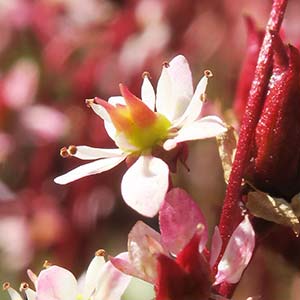Micranthes lyallii
Micranthes tenuis
Lyall's saxifrage, red-stem saxifrage
slender saxifrage
basal;
petiole rounded to flattened, 2–10 cm;
blade spatulate to obovate, 0.8–8 cm, thin, base cuneate to slightly attenuate, margins serrate to dentate, eciliate or sparsely glandular-ciliate, surfaces abaxially glabrous, adaxially sparsely brown-hairy.
basal;
petiole broad, flattened, 0.2–1 cm;
blade ± obovate to ± obtrullate, 0.5–1.5 cm, ± coriaceous, base ± attenuate to ± cuneate, margins serrate to dentate on distal 1/3–2/3, sometimes ciliate, surfaces glabrous or glabrate abaxially (rarely sparsely reddish brown-hairy).
usually 10–15-flowered, lax, cylindric thyrses, (red), (4–)7–30 cm, sparsely purple-tipped stipitate-glandular.
usually 2–10-flowered, ± capitate cymes, sometimes solitary flowers, (1–)2–7(–11) cm, hairy or glabrous proximally, glabrate or ± purple-tipped stipitate-glandular distally. (Pedicels proximal ± elongate.) Flowers: sepals erect, ovate to deltate;
petals white with purple margins, usually pink or purple tinged, not spotted, obovate to oblong, clawed, 2–3 mm, usually slightly longer than sepals;
filaments linear, flattened;
pistils connate to 1/2 their lengths;
ovary 1/2 inferior, appearing more superior in fruit.
sepals reflexed, oblong to elliptic;
petals white, each with 2 basal yellowish green spots, elliptic to round, clawed, 2–5.5 mm, longer than sepals;
filaments club-shaped, (to 6 mm);
pistils connate 1/2+ their lengths;
ovary superior, (to 1/3 adnate to hypanthium).
green to yellow, distal 1/2 purple, ± folliclelike, (basally connate).
reddish to purplish, folliclelike.
= ca. 56, 58.
= 20.
Micranthes lyallii
Micranthes tenuis
Although they have nearly disjunct sets of populations, the subspecies of Micranthes lyallii are difficult to distinguish from each other. The more northern plants tend to be larger with wider leaves and often have been called Saxifraga lyallii subsp. or var. hultenii. Apparent hybrids with M. odontoloma occur in Alberta, British Columbia, and northern Idaho, and near Glacier National Park, Montana.
(Discussion copyrighted by Flora of North America; reprinted with permission.)
Micranthes tenuis is morphologically distinguished from M. nivalis only with great difficulty. D. A. Webb and R. J. Gornall (1989) claimed that chromosome number is one of the chief reasons for continuing to recognize the species and, indeed, their enumeration of morphologic differences is not entirely convincing. Occasionally, both species appear to occur in the same populations. The generally smaller size, tendency to glabrousness, fewer number of flowers, and petal color variations reasonably distinguish M. tenuis. Depauperate specimens of M. nivalis are particularly difficult to separate from M. tenuis except for their very consistent hairiness and white petals. Due to the morphologic confusion, exact distributions are difficult to assess and chromosome number reports may be doubtful (D. L. Krause and K. I. Beamish 1973). A thorough systematic study is needed.
(Discussion copyrighted by Flora of North America; reprinted with permission.)
- Local floras:
BC
- Local Web sites:
PNW Herbaria
WildflowerSearch
iNaturalist (observations)
- LBJ Wildflower Center
- SEINet
- Plants of the World Online
- Encyclopedia of Life
- Wikipedia
- Google Image Search


